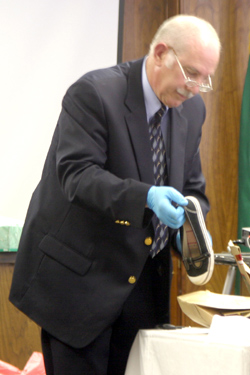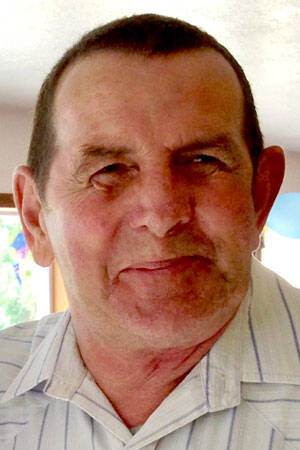

Detective Mike Murray holds up Michelle Kitterman’s left shoe, which was found near her body, for the jury to see as evidence toward the end of testimony Monday, April 19. Murray also showed the shirt, jacket, jeans and bra Kitterman was wearing the night
OKANOGAN – After a full day of testimony on Monday, April 19 at the murder trial of Tansy Mathis and David Richards, testimony was expected to continue through the early part of the week with the jury receiving the case by the end of the week for deliberation.
The two defendants are on trial for the murder of Michelle Kitterman. Brent Phillips, a third defendant has pled guilty to taking part in the killing in a plea agreement and has already given testimony. A fourth person, Lacey Hirst-Pavek, is sent to face charges in connection with the killing as well.
The main witness on April 19 was Dr. John Butt, a forensic pathologist with a private expert advice firm in Vancouver, B.C. Butt was called upon by the defense to testify to the age of Michelle Kitterman’s unborn child at the time of her death. Although Butt had never worked with a case involving an unborn child’s death, he was called upon for his expert advice in forensic pathology, since he has been in private practice for 10 years and has been working in the field for even longer.
To form his opinion on the possibility of Kitterman carrying a quick child, meaning she had felt movement from the child before her death, Butt referred to articles he had found while preparing for his testimony for this case. He said the articles were about two studies conducted, in the 1980s, on when 618 women (200 for one study and 418 for the other) felt the first quickening from their unborn child. Although Butt did not perform the autopsy on Kitterman, or physically examine the fetus, he determined the age by measuring, to scale, the size of the fetus in an autopsy photo and by comparing it to his research.
The issue of whether or not Kitterman was carrying a quick child comes as a result of the manslaughter charge against Tansy Mathis and David Richards. From the autopsy photos, Butt measured the size of the child, which he determined to be just under two inches long, which indicates a child less than nine weeks along in gestational development. Butt said the articles each referenced the earliest feeling of movement happening at the 14th week.
In response to this, Prosecuting Attorney Karl Sloan questioned Butt about whether he is familiar with the effects of methamphetamine on fetal development, to which Butt said not specifically, but that he knows most drugs don’t promote fetal growth. When Sloan asked if Butt was familiar with research that shows the drug makes fetal growth smaller for gestational age, Butt replied no he didn’t, but that he wasn’t surprised. Also, when Sloan asked Butt if he had taken methamphetamine use into account when determining the age of the fetus, Butt replied that no, he had not. Sloan’s last question to Butt was whether or not gestational age and quickening were dependent on each other, asking if one is based on the other, Butt replied that no, they are not.
At the beginning of the day, the State called on Renee Peak, who has known Richards for 11 years and says she is like a sister to him. Peak said she knew that Richards had planned on leaving town to “tax someone” and he would be paid for the job, but she also knew he had not gone on the trip.
“[Richards] said he did not go to Okanogan because it wasn’t in his nature because she was a pregnant woman,” Peak said. “He said they were supposed to frighten her to abort the baby.”
The State also called upon Erin Schibel, Phillips’ girlfriend at the time of Kitterman’s death. Schibel said she lived at Richards’ house with Phillips and that she knew Phillips was going out of town. She said she had seen a blond woman previously and had heard her speak Spanish and had seen her with her young daughter. She said this woman drove a white minivan and that when she would come to Richards’ house, everyone would have to leave the house or stay out of sight in a back room. At the time of Mathis’ arrest, her hair was dyed blond. Previous testimony in this case has been that Mathis drove a minivan and has a small daughter.
Schibel said the last time she saw Phillips was within 24 hours after he returned from his trip. She said he was beside himself, really upset, but that he didn’t want to talk about what had happened on the trip. About three weeks after this, Schibel left the Spokane area and has been in recovery for meth use since then.
When Defense Attorney Steve Graham asked what Schibel saw in Phillips, she responded that he was very protective of her, was not aggressive toward her and that he took care of her.
The final witness of the day was Detective Mike Murray, who was recalled to the stand by Prosecutor Sloan. They went over Mathis’ phone records for the night of Feb. 28, 2009 and into the morning of March 1, 2009, showing that Mathis had called Richards, her boyfriend, Steve Peña, and Lacey Hirst-Pavek, several times throughout the night and had also received several calls from them as well.
They then discussed Richards’ interview with Murray on March 25, 2009, during which Richards told Murray that Phillips had stolen his ice-pick to do someone a favor. Richards’ told Murray during this interview that Phillips told him he had “taxed a woman” and it had gotten messy. Later on, Richards’ said Phillips had told him he’d burned part of the ice-pick and thrown the other part into the river.
The last portion of Murray’s testimony involved him taking out evidence bags from the Okanogan County Sheriff’s Office which contained the clothing worn by Kitterman on the night she was murdered. Murray demonstrated to the jury how the shirt Kitterman wore was damaged with tears and small holes by tagging each one with a colored tag. He then did the same for the back of Kitterman’s jacket as well as the bra she was wearing when she was found. Murray also examined the jeans Kitterman was wearing up until her autopsy. The jeans did not have any signs of damage that Murray could find and still had the button and zipper intact. Finally, as his testimony for the day ended, Murray brought out Kitterman’s shoes to show the jury.


